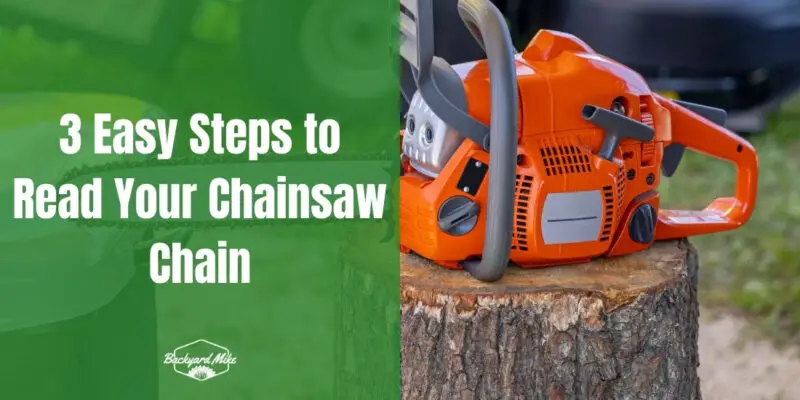To read your chainsaw chain, first determine the pitch by measuring the distance between three consecutive rivets, then divide by two. Next, gauge the chain by checking the thickness of the drive links with calipers or referring to your chainsaw bar or manual. Finally, count the drive links, laying the chain flat and tallying by twos for accuracy. Accurately understanding these specs guarantees your chainsaw operates smoothly and safely. Discover more by revealing additional insights.
Key Takeaways
- Measure the distance between three consecutive rivets and divide by two to determine the chain pitch.
- Use calipers to measure the drive link thickness for accurate gauge identification.
- Count the drive links by laying the chain flat and counting by twos.
- Check the chainsaw bar for stamped chain specifications for quick reference.
- Ensure the chain pitch, gauge, and length match the saw's sprocket and bar for optimal performance.
Determine the Pitch of Your Chainsaw Chain
To determine the pitch of your chainsaw chain, you'll need to measure the distance between its drive links. Start by using measurement tools like a ruler or caliper. Accurately measure the distance between three consecutive rivets, then divide by two. This calculation will give you the chain's pitch. Understanding chain specifications is essential for ensuring your chainsaw operates smoothly and safely. Common pitch sizes include 3/8", .325", and 3/4". It's crucial to select the right chain for your intended task to ensure safety and performance. Remember, the pitch should match the saw's sprocket and bar for ideal performance. Tools like the Oregon Tool or Stihl Control Tool can help with precision. It's important to double-check measurements and consult manuals to prevent sizing errors that could cause binding or derailment.
Measure the Gauge of Your Chainsaw Chain
Understanding the gauge of your chainsaw chain is essential for safe and efficient operation. The gauge refers to the thickness of the drive links that fit into the guide bar groove, ensuring a snug fit and preventing chain compatibility issues. The importance of checking the bar for chain details cannot be overstated, as it helps ensure that the chain fits correctly and operates safely. Regular maintenance, including sharpening and oiling, is crucial for optimal performance and durability when using chainsaw chains.
Understanding the chainsaw chain gauge is crucial for ensuring safety and compatibility during operation.
To measure the gauge accurately, consider these gauge measurement techniques:
- Caliper Use: Use calipers for precise thickness measurement of a single drive link.
- Go/No-Go Gauge: Employ specialized gauges to check for a snug fit without being too tight.
- Awareness of Markings: Check for gauge information stamped on the chainsaw bar or in the user manual.
Ensure the gauge matches your guide bar to avoid excessive wear and safety hazards like chain derailment.
Regular gauge checks maintain both safety and performance.
Count the Drive Links on Your Chainsaw Chain
Accurately counting the drive links on your chainsaw chain is essential for guaranteeing it fits your chainsaw properly and operates effectively. Begin by identifying the drive links—these are the teeth on the bottom of the chain that slot into the guide bar's groove. Accurate counting is critical; it determines the correct chain length and affects performance. Remember, the correct drive link count ensures proper chain fit, preventing malfunction and enhancing safety. To count drive links, lay the chain flat, line it end to end, and count by twos for efficiency. Placing a strip of tape on the first link can help track your progress.
Frequently Asked Questions
How Do I Safely Store My Chainsaw Chain?
For effective chainsaw storage and chain protection, clean and dry the chain first. Lubricate it with bar oil, then store it in a cool, dry area. Use a chain locker to prevent tangling and guarantee safety.
What Tools Are Needed for Chainsaw Chain Maintenance?
When tackling chain maintenance, you'll need to select the right tools like a RatchetScrench, round files, and grease guns. Joining fellow chainsaw enthusiasts, you'll guarantee your chainsaw's peak performance and share in the satisfaction of a job well done.
Can I Use Any Brand of Chain on My Chainsaw?
You can use different brands of chains on your chainsaw, but it's essential to guarantee chain compatibility with your saw's specifications. Prioritize brand quality for peak performance and safety, making you part of a knowledgeable community.
How Often Should a Chainsaw Chain Be Replaced?
You should replace your chainsaw chain when its life ends due to wear or damage. Replacement frequency depends on your usage, maintenance habits, and cutting materials. Keep your chain's condition in mind to guarantee efficient performance.
What Are the Signs of a Worn-Out Chainsaw Chain?
Imagine your chainsaw as a dance partner. When it loses rhythm—chain tension wavers, cutting efficiency falters, and vibrations disrupt harmony—it's time to replace the chain. Keep your tool sharp to stay connected with your work community.
Conclusion
By understanding how to read your chainsaw chain, you've revealed the key to maintaining its efficiency and safety. First, determine the pitch by measuring the distance between links. Next, measure the gauge by checking the thickness of the drive links. Finally, count the drive links to guarantee the right fit. Like a well-tuned instrument, a correctly maintained chainsaw performs smoothly, offering precision and reliability. With these steps, you're ready to tackle any cutting task confidently.


